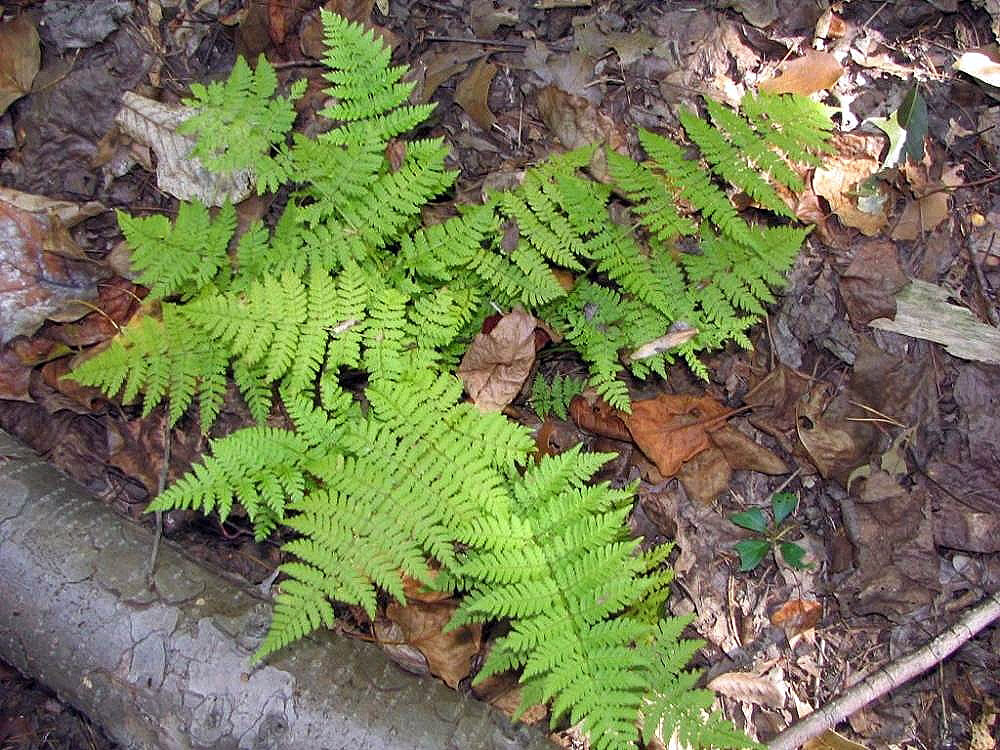Exploring Woodland Islandfern
Scientifically recognized as Dryopteris intermedia and classified under Dryopteridaceae, stands out as a distinctive Fern known for its unique characteristics. While it may also be found under other Synonyms, None noted.withNone noted form. You can use our free plant care app PlantPlants to identify Woodland Islandfern.
Temperature
Min 40 F (4 C), Max 85 F (29 C)
Watering
Regular watering to keep soil consistently moist
Fertilizing
Balanced liquid fertilizer (e.g., 10-10-10)
Sunlight
Partial to full shade
Toxicity
Not known to be toxic, but young fronds should be cooked



Appearance and Growth Of Woodland Islandfern
At maturity, this species reaches approximately 1 to 3 feet tall, presenting Pinnate, dark green fronds, lanceolate to ovate in shape along with Non-flowering (ferns reproduce via spores), followed by Spores are produced in sori on the underside of fronds. These features are supported by a reliable Rhizomatous root system, ensuring stability and sustained growth.
Woodland Islandfern Origin and Habitat
Native to Native to North America, Woodland Islandfern thrives in Moist, shady woodlands at elevations around Prefers low to moderate elevations. Best suited for USDA Hardiness Zone 3 to 8. Whether grown indoor, in a curated garden or a more natural setting, its ecological requirements help maintain its vigor over time.



How to take Care of Woodland Islandfern
Light, Soil and Watering Woodland Islandfern.
You can use our free plant identify app PlantPlants to chose the best spot for Woodland Islandfern, This plant prefers Partial to full shade and flourishes in Rich, well-drained, moist soils with a soil pH of about 5.0 to 7.0.
Woodland Islandfern needs watering,Regular watering to keep soil consistently moist, guided by PlantPlants app, You can get plants daily watering schedule. to maintain High moisture preference, ensure steady hydration. Applying water through Ground watering to avoid wetting the foliage supports even distribution and helps prevent overwatering or dryness.
Temperature and Humidity
Woodland Islandfern performs best within 50 F to 75 F (10 C to 24 C). Its ideal growth occurs at around 60 F to 70 F (15 C to 21 C), though it tolerates ranges from Min 40 F (4 C), Max 85 F (29 C). Additionally, maintaining High humidity preferred encourages healthy foliage and overall plant vigor.
Fertilization & Soil Health
Feeding with Balanced liquid fertilizer (e.g., 10-10-10) at the recommended Seasonal Application Frequency on PlantPlants App keeps nutrients balanced. Incorporating Leaf litter or compost enhances soil structure and fertility, while staying alert to Yellowing of fronds, poor growth helps you adjust care as needed to maintain optimal plant health.
Routine and Maintenance
Regular attention ensures this plant’s beauty and longevity. Spring after new growth begins for Remove dead or brown fronds tidies its appearance, while Every 2-3 years may be necessary as it grows, requiring a Increase by 1-2 inches in diameter increase and a fresh A mix of potting soil with organic matter. for Staking or Support. Not needed.
Seasonal Changes and Propagation of Woodland Islandfern
During Winter, growth may slow and some Evergreen, may turn brown in winter but will revive in spring can occur. For those looking to propagate, consider Spores or division of the rhizome and provide Warm temperatures, high humidity when starting from seed. If using cuttings, follow Not applicable as ferns do not root from cuttings unless divided. to ensure successful rooting and healthy new plants.
Pests, Diseases and Prevention
our free plant identify and care app PlantPlants can help you diagnosisWoodland Islandfern problems.Though generally robust, keep watch for None majorly noted, but may be susceptible to aphids and remain vigilant against Root rot if conditions are too wet. Implementing Ensure good drainage and avoid waterlogging and applying If pests appear, use insecticidal soap; improve drainage for root rot when issues arise will help sustain the plant thriving.
Companions and Uses of Woodland Islandfern
This plant pairs nicely with Hostas, ferns, and shade-tolerant ground covers and shows None noted, making it a flexible choice for various Ideal for shade gardens, woodland settings, and as ground cover.
Edible and Cultural Aspects
the Edible Parts: Young fronds (fiddleheads). Toxicty of Woodland Islandfern, Not known to be toxic, but young fronds should be cooked. learning about its Late spring; harvest fiddleheads before they unfurl, Used in salads, soups, and as a vegetable; can be pickled, and High in vitamins A and C, and provides fiber can be intriguing for culinary explorers. Some traditions highlight its Traditionally used by Indigenous peoples for various ailments or note its Often featured in native plant gardens; respected for its beauty.
Conservation and Status
With an Not listed, proper Habitat preservation and propagation efforts in shaded areas
Frequently Asked Questions
1. How often should I water Woodland Islandfern?
Water every 5-7 days in summer, keeping the soil moist.
2. What type of soil is best for Woodland Islandfern?
Well-drained, rich, and moist soil is ideal.
3. Does Woodland Islandfern need direct sunlight?
No, it prefers partial to full shade.
4. Can the fronds of Woodland Islandfern be eaten?
Yes, young fiddleheads can be consumed after cooking.
5. When is the best time to repot Woodland Islandfern?
Every 2-3 years, preferably in spring.
6. How can I propagate Woodland Islandfern?
You can propagate by division of the rhizomes or by spores.
7. Are there any pests I need to worry about?
Generally, it is pest-resistant but may encounter aphids.
8. Does Woodland Islandfern go dormant in winter?
Yes, it can slow growth considerably and may look brown or wilted.
9. How can I improve the growth of my Woodland Islandfern?
Keep it in a humid environment with consistently moist soil and regular fertilization.
10. What is the ideal temperature range for Woodland Islandfern?
It thrives best in temperatures between 60 F and 70 F (15 C to 21 C).


